Sunday, 25 July 2010: Luxembourg to Bastogne: The Battle of the Bulge
Written 15 July 2010
Getting out of Luxembourg was more complicated than it sounded. We got up promptly, breakfasted, packed, and trundled our luggage off toward the parking garage. Signs all over the place had warned us to keep our parking ticket with us, as the garage would be locked on Sunday, and we would need it to get to the car. As far as we could tell, though, the doors were open, and anyone could walk in. It was one of those systems where, when it's time to leave, you stick your ticket into a machine in the front lobby. The machine then displays the amount you owe, you stuff money (or a credit card) in until it's satisfied, and it returns your ticket, now coded to tell the machine at the gate that you've paid and are free to go. We duly stuck our ticket into the slot and noted the total: 39 euros and change. Our American credit cards don't always work in such machines, which expect cards with chips, so we started feeding bills into the machine. That got us up to 35 euros. David had a 2-euro coin that got us up to 37. I then dug out the large fistful of change I had accumulated, and we fed that in until we ran out of coins large enough to work (the machine wouldn't take anything smaller than a 2o-cent piece). Aaargh! 40 cents short! Rather than hike off in search of an ATM, we tried cancelling the transaction, so as to start over with the credit card, but rather than the cascade of coins I expected (you never get bills back out of a machine like that—I thought we'd get 39 euros in coins), we got back only the coins we had put in. Aaargh again! But wait; according to the display, we owed less than 5 euros—we still had credit for the 35 in bills! So, with some trepidation, David gave it the credit card, and voila! It asked for a pin number, charge just 4 euros and change to the card, and gave us back our validated ticket. Whew.
So we got into the elevator, tried to remember what level the car was on, guessed wrong, and, when we tried to reenter the elevator lobby to go down farther, found it locked. Drat. So we dragged the luggage down the ramps another level (better than the stairs) and found the car. Next came the question of the license plate. Remember the license plate, held on by just one screw? David examined the problem more carefully and realized that the problem was not that the screw holes were stripped but that the screws were the wrong size to begin with! He tried a variety of solutions, using the nail file on my Swiss army knife as a screwdriver, trying the second (loose) screw in different corners of the plate, and finally, with the aid of a good deal of scotch tape from the roll in my suitcase, arrived (after about 40 minutes) at an arrangement that we hoped would keep the plate from falling off in the next few days.
Pack everything into the car, proceed to the exit, stick the ticket into the gate machine, only to be told that, sorry, our check-out had expired. Another 40 cents please. Drat. Back out of the exit lane and fine another parking space. I guarded the car and the luggage while David hiked back to the machine with the fistful of change.
Then, inevitably, that happened that I dread above all things when leaving a new parking garage for the first time—the exit was not on the same side as the entrance! We emerged into a different street entirely, who knew where and facing some random direction. But wait! I know that street name, turn left here! And there we were, on our way over the causeway, out of town, on just the radius we would have chosen—you can't lose them all.
The run from Luxembourg to Bastogne was a short one—we were there by lunch time. The route led through the heavily forested and notoriously rugged Ardennes mountains, which David was pleased to gain a visual appreciation of, because of their historic role in military strategy in the region. This was where Hitler, in a last desparate attempt to break through the allied lines, massed his remaining troops and pushed over the Ardennes and deep into allied territory, stretching (but not breaking) the lines into a a very large salient, the bulge, before being pushed back and ultimately defeated.
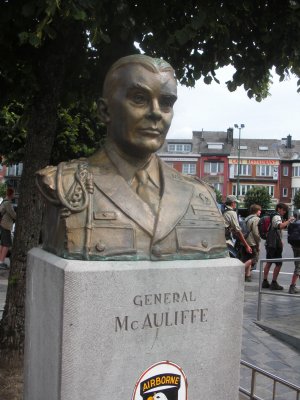
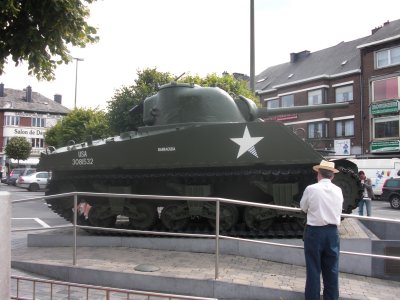 The town of Bastogne, sitting in a largish valley and break in the forest, and at the nexus of the road network, was directly in the path of Hitler's forces, and as the bulge pushed past it, managed to hold on and became an island of allied territory completely surrounded by newly German-occupied land. It was defended by Americans (a composite group made up of scattered units that fell back on Bastogne as the Germans advanced, part of an armored unit, and a bunch of aireborne troops that were diverted and rushed there by truck), under the command of General Anthony C. McAuliffe. He's the one who, once surrounded and presented with a German surrender ultimatum, famously replied "Nuts." The German commander had to consult a rather embarrassed interpreter who translated the message, accurately enough, as "Go to the devil." He and his troops held out for between two and three weeks, until General Patton blasted his way in from the south (where the distance from the main lines to the besieged town was shortest) and relieved them.
The town of Bastogne, sitting in a largish valley and break in the forest, and at the nexus of the road network, was directly in the path of Hitler's forces, and as the bulge pushed past it, managed to hold on and became an island of allied territory completely surrounded by newly German-occupied land. It was defended by Americans (a composite group made up of scattered units that fell back on Bastogne as the Germans advanced, part of an armored unit, and a bunch of aireborne troops that were diverted and rushed there by truck), under the command of General Anthony C. McAuliffe. He's the one who, once surrounded and presented with a German surrender ultimatum, famously replied "Nuts." The German commander had to consult a rather embarrassed interpreter who translated the message, accurately enough, as "Go to the devil." He and his troops held out for between two and three weeks, until General Patton blasted his way in from the south (where the distance from the main lines to the besieged town was shortest) and relieved them.
This bust of McAuliffe is located in the town's central square, next to the restored Sherman tank (one of those brought in by the armored unit) that David is admiring.
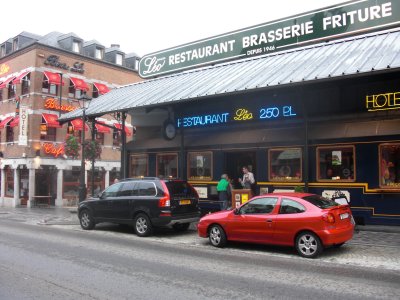 Our hotel was also on the square (the town isn't very large) and was part of a thriving little empire centered on a restaurant called Wagon Léo. As you can see from the photo, it started out as a railroad restaurant car (one of two in the town), but it has since expanded into the building behind it, and the owners have also acquired two small hotels in adjacent buildings. And I do mean small. Note only does each of the hotels have only six rooms, but their lobbies carry compactness to amazing extremes. We parked in the square, and I walked over to consult the reception desk about when our rooms would be ready (it was still midmorning) and where we could park overnight. When I presented myself at the hotel, "Léo at Home," a couple of doors down from the restaurant, I found that "reception" consisted of a little speaker in the wall, in the recessed doorway. The first few times I pushed the button, I got a busy signal, but at last someone answered and told me it was too early—come back at 2 p.m., when reception would be open. I protested (shouting over the traffic noise) that I had questions and that we wanted to drop off our luggage even if our rooms weren't ready. "Okay, I'm coming"; she apparently had to walk over from the restaurant.
Our hotel was also on the square (the town isn't very large) and was part of a thriving little empire centered on a restaurant called Wagon Léo. As you can see from the photo, it started out as a railroad restaurant car (one of two in the town), but it has since expanded into the building behind it, and the owners have also acquired two small hotels in adjacent buildings. And I do mean small. Note only does each of the hotels have only six rooms, but their lobbies carry compactness to amazing extremes. We parked in the square, and I walked over to consult the reception desk about when our rooms would be ready (it was still midmorning) and where we could park overnight. When I presented myself at the hotel, "Léo at Home," a couple of doors down from the restaurant, I found that "reception" consisted of a little speaker in the wall, in the recessed doorway. The first few times I pushed the button, I got a busy signal, but at last someone answered and told me it was too early—come back at 2 p.m., when reception would be open. I protested (shouting over the traffic noise) that I had questions and that we wanted to drop off our luggage even if our rooms weren't ready. "Okay, I'm coming"; she apparently had to walk over from the restaurant.
She locked our luggage in a little room inside, then directed us around the block to the parking area behind the restaurant. The entrance to the alley was at one end of the block and the parking area at the other, so we got a good view of the backs of the buildings facing the square, and the difference was astonishing. As you can see in the photos, the façades on the square were smart and well kept, with gaily colored awnings and painted trim, but the alley behind them is a tree-shaded, unpaved country lane lined with dilapidated old stone buildings—you'd think you were on a very old and very rural farm! At the end of the lane, though, was the spruce and neatly paved parking lot, just below the restaurant's spacious back deck.
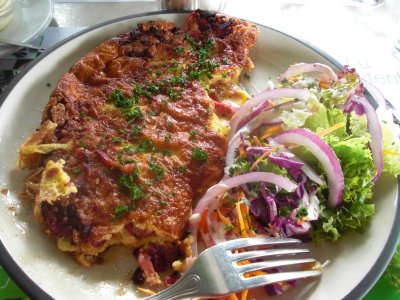
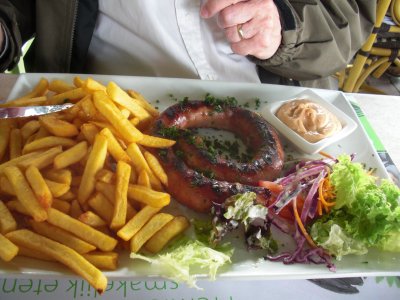 Next on the agenda was lunch, so we prospected around the square and decided on a restaurant called "Le Nut's." I had an ordinary omelette aux lardons, but David couldn't resist the "GI's menu," which offered three choices, the "30 calibre" (1/4 meter of grilled sausage, fries, salad, and 1/4 liter of either coke or beer; choice of sauce, sweet or hot), the "50 calibre" (same thing but with 1/2 meter of sausage), and the "barracuda" (same thing but with the full meter of sausage!). He chose the 30 calibre and, of course, couldn't finish it.
Next on the agenda was lunch, so we prospected around the square and decided on a restaurant called "Le Nut's." I had an ordinary omelette aux lardons, but David couldn't resist the "GI's menu," which offered three choices, the "30 calibre" (1/4 meter of grilled sausage, fries, salad, and 1/4 liter of either coke or beer; choice of sauce, sweet or hot), the "50 calibre" (same thing but with 1/2 meter of sausage), and the "barracuda" (same thing but with the full meter of sausage!). He chose the 30 calibre and, of course, couldn't finish it.
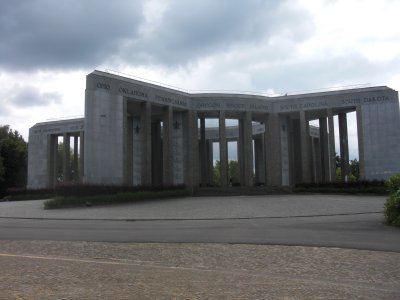
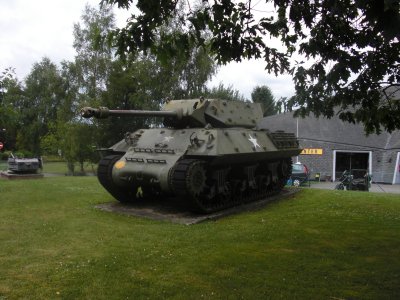 Aside from the monuments in the square, the things to see at Bastogne were mostly centered about 2 km out of town at Mardasson Hill, which is crowned by a star-shaped monument bearing the state names and insignia of all the American units that took park in the Battle of the Bulge. We found the unit David's uncle Al Smith served in, though he was on the "north shoulder" of the bulge rather than in Bastogne. He and his comrades must have been more action than just about anyone else in that war. They came ashore in Normandy, a few days after D-Day, and fought their way north, on foot, stopping to join just about every major battle along the way, until arriving in northern Belgium just in time for the bulge—incredible. We climbed to the top of the monument to admire the view and to study the directional tables at each point, which indicated where various parts of the battle and siege took place.
Aside from the monuments in the square, the things to see at Bastogne were mostly centered about 2 km out of town at Mardasson Hill, which is crowned by a star-shaped monument bearing the state names and insignia of all the American units that took park in the Battle of the Bulge. We found the unit David's uncle Al Smith served in, though he was on the "north shoulder" of the bulge rather than in Bastogne. He and his comrades must have been more action than just about anyone else in that war. They came ashore in Normandy, a few days after D-Day, and fought their way north, on foot, stopping to join just about every major battle along the way, until arriving in northern Belgium just in time for the bulge—incredible. We climbed to the top of the monument to admire the view and to study the directional tables at each point, which indicated where various parts of the battle and siege took place.
Next to the monument was a good-sized museum (with a Sherman tank out front, of course) displaying period uniforms, equipment, and artifacts (a sign on the front desk said, in many languages, "Just say hello, so we'll know what language you speak") . The audioguides were a little flaky (mine abruptly switched from French to Spanish in mid narration, and I had to go back to the reception desk to have it reprogrammed; David's English one apparently behaved itself better) but conveyed a lot of information nonetheless. I was amused, though, when the French narrator said this was the museum of the Battle of the Ardennes, "which the Americans call 'ze bat-tell of ze boolg'." At one point, I was studying a case full of field gear when a trio of young American men with short haircuts stopped and pointed out a leather holster, saying "Look, that's just like the one we found the other day, except that ours had a button, right there in the middle of the flap." They were clearly very knowledgeable about the stuff in the cases, and I was on the point of asking them whether they were here with the military, at one of the many bases in the area, when they addressed themselves to an older American man wearing a Marine Corps bill cap, shaking his hand and saying, "Excuse me, sir; we just wanted to thank you for your service." He asked them where they were from (while I eavesdropped for all I was worth), and they said they were with "WWII recovery," in the area looking for artifacts. I guess they and their buddies are the ones who do all the scuba diving and excavation to recover all this stuff we see in museums, and maybe even ordnance, too.
Among other things we learned in the museum is the etymology of the word "Jeep." Seems to me I learned this once before, long ago, but had forgotten it. The word comes from the initials "GP," for "general purpose" (vehicle). We saw ads for personalized battlefield tours in vintage jeeps, but we didn't have time to look into it.
Once we finished at the museum, we took a drive out into the countryside, as David wanted to see more of the local terrain, to help get a better idea of conditions during the battle. Driving back into town, from a new direction this time, we passed a large carnival set up in what would ordinarily be the open market place. We parked in the back alley again, then walked around to the front and pushed the "reception" button again, hoping to recover our luggage and check into our room. This time our call was answered by a small, thin, wiry older man in a great hurry—I got the impression he might be the owner/chef. He came bustling over from the restaurant, retrieved our luggage, and led the way back out in to the square, down the street past the restaurant, around the corner to the left (quite close to where our car was parked), and into the lobby of the second of the two hotels (in the building with the red awnings you can see in the photo above).
This lobby, which was at least not open to the street like the other one, was about the size of our dining-room table. It had nice carpet, a potted plant, a little desk, a cabinet, and just room enough for the three of us and our luggage, standing very close together. To make a copy of our identification, he had to open the cabinet, pull out a little photocopier, turn it 90 degrees so that the paper tray could open, and plug it in—the cabinet wasn't deep enough for it to stay in working position, even with the paper tray closed. He then, still in a great hurry, grabbed a couple of our heavier pieces and led the way up an extremely narrow (but plushly carpeted) wooden spiral staircase (no doubt, originally the "back stairs" to the servants' quarters), pausing to point out the door to the breakfast room on the first landing, then continuing up another floor to our room before hurrying away, back to the kitchens, I guess. The room was quite nice, clearly newly renovated and with all the modcons and excellent plumbing—I guess if you're short of space better to put it in the guest rooms than in the lobby.
At dinner time, we just strolled back round the corner to the restaurant, where we were seated in the older part, in the actual dining car. The place was very busy, and many of the diners seemed to be regulars. The specialty is seafood, many varieties of which could be ordered in any of several preparations. On the back page of the menu of plastic-laminated menu was a long list of fish and shellfish (including half a dozen different kinds of oysters); next to each item was a circle, and little colored peel-and-stick signal dots had been pasted into the circles next to those that had come in fresh that day. They must have to redo those dots daily, according to what comes into the ports and gets delivered. You know you can trust a seafood kitchen run on those lines! While we read the menus, they brought us an amuse bouche of peanuts and glasses of chilled gazpacho.
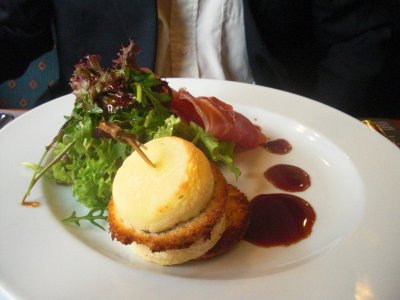
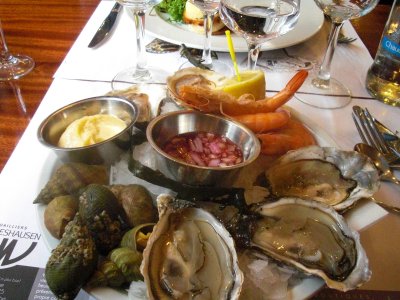 David started with a roasted goat cheese (a special "cabecou" from a named region) and artisanal ham (matured for 20 months!), served with "sirop de Liège" (a sort of intensely concentrated apple and pear preserve) made with beer. I jumped at the cold seafood starter. I got a platter of five oysters (3 "deep" and 2 "flat"), several shrimp, and a little heap of "bulots" (small whelks), served with lemon, house-made mayo, and mignonette sauce (vinegar and shallots, for the oysters). Excellent. Long experience has taught me to ignore the mignonette—I like my oysters with lemon and pepper. The bulots were great )I love bulots with mayo), but the oysters were outstanding. The flat ones were good, but the deep ones were the best oysters I've ever eaten in my life!
David started with a roasted goat cheese (a special "cabecou" from a named region) and artisanal ham (matured for 20 months!), served with "sirop de Liège" (a sort of intensely concentrated apple and pear preserve) made with beer. I jumped at the cold seafood starter. I got a platter of five oysters (3 "deep" and 2 "flat"), several shrimp, and a little heap of "bulots" (small whelks), served with lemon, house-made mayo, and mignonette sauce (vinegar and shallots, for the oysters). Excellent. Long experience has taught me to ignore the mignonette—I like my oysters with lemon and pepper. The bulots were great )I love bulots with mayo), but the oysters were outstanding. The flat ones were good, but the deep ones were the best oysters I've ever eaten in my life!
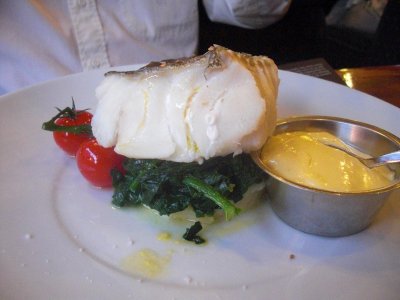
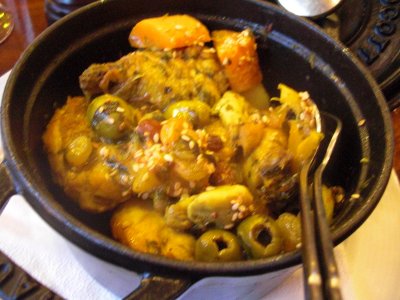 David's main course was a slab of outstanding fresh cod with sautéed spinach, roasted cherry tomatoes, and mousseline sauce (a sort of fluffy hollandaise). I chose the special, a chicken tajine with olives, carrots, golden raisins, and preserved lemon, sprinkled with sesame seeds (tajines are really catching on in Belgium, where a lot of the kitchen help is north African; we saw them on a number of otherwise non-African menus).
David's main course was a slab of outstanding fresh cod with sautéed spinach, roasted cherry tomatoes, and mousseline sauce (a sort of fluffy hollandaise). I chose the special, a chicken tajine with olives, carrots, golden raisins, and preserved lemon, sprinkled with sesame seeds (tajines are really catching on in Belgium, where a lot of the kitchen help is north African; we saw them on a number of otherwise non-African menus).
I finished up with a "coupe amarena" (vanilla ice cream with sour-cherry sauce; that is the cherries were sour, not the sauce), which I gobbled up so fast I forgot to photograph it.
After dinner, we strolled down to check out the carnival, and it was a genuine for-profit carnival, not a town festival or charity thing. Some food was for sale, but it was pretty limited and ran heavily to candy. Mostly it was carnival rides and row on row of "game" booths—you know, three baseballs, or three ring tosses, or three shots, or whatever for a dollar, try to win the giant teddy bear. And for the little kids, the flume full of little floating plastic ducks and the pony rides, just like the North Carolina State Fair when I was a kid, but without the livestock shows. It was too loud and probably crawling with pickpockets, so we didn't stay long.
previous entry
List of Entries
next entry

 The town of Bastogne, sitting in a largish valley and break in the forest, and at the nexus of the road network, was directly in the path of Hitler's forces, and as the bulge pushed past it, managed to hold on and became an island of allied territory completely surrounded by newly German-occupied land. It was defended by Americans (a composite group made up of scattered units that fell back on Bastogne as the Germans advanced, part of an armored unit, and a bunch of aireborne troops that were diverted and rushed there by truck), under the command of General Anthony C. McAuliffe. He's the one who, once surrounded and presented with a German surrender ultimatum, famously replied "Nuts." The German commander had to consult a rather embarrassed interpreter who translated the message, accurately enough, as "Go to the devil." He and his troops held out for between two and three weeks, until General Patton blasted his way in from the south (where the distance from the main lines to the besieged town was shortest) and relieved them.
The town of Bastogne, sitting in a largish valley and break in the forest, and at the nexus of the road network, was directly in the path of Hitler's forces, and as the bulge pushed past it, managed to hold on and became an island of allied territory completely surrounded by newly German-occupied land. It was defended by Americans (a composite group made up of scattered units that fell back on Bastogne as the Germans advanced, part of an armored unit, and a bunch of aireborne troops that were diverted and rushed there by truck), under the command of General Anthony C. McAuliffe. He's the one who, once surrounded and presented with a German surrender ultimatum, famously replied "Nuts." The German commander had to consult a rather embarrassed interpreter who translated the message, accurately enough, as "Go to the devil." He and his troops held out for between two and three weeks, until General Patton blasted his way in from the south (where the distance from the main lines to the besieged town was shortest) and relieved them. Our hotel was also on the square (the town isn't very large) and was part of a thriving little empire centered on a restaurant called Wagon Léo. As you can see from the photo, it started out as a railroad restaurant car (one of two in the town), but it has since expanded into the building behind it, and the owners have also acquired two small hotels in adjacent buildings. And I do mean small. Note only does each of the hotels have only six rooms, but their lobbies carry compactness to amazing extremes. We parked in the square, and I walked over to consult the reception desk about when our rooms would be ready (it was still midmorning) and where we could park overnight. When I presented myself at the hotel, "Léo at Home," a couple of doors down from the restaurant, I found that "reception" consisted of a little speaker in the wall, in the recessed doorway. The first few times I pushed the button, I got a busy signal, but at last someone answered and told me it was too early—come back at 2 p.m., when reception would be open. I protested (shouting over the traffic noise) that I had questions and that we wanted to drop off our luggage even if our rooms weren't ready. "Okay, I'm coming"; she apparently had to walk over from the restaurant.
Our hotel was also on the square (the town isn't very large) and was part of a thriving little empire centered on a restaurant called Wagon Léo. As you can see from the photo, it started out as a railroad restaurant car (one of two in the town), but it has since expanded into the building behind it, and the owners have also acquired two small hotels in adjacent buildings. And I do mean small. Note only does each of the hotels have only six rooms, but their lobbies carry compactness to amazing extremes. We parked in the square, and I walked over to consult the reception desk about when our rooms would be ready (it was still midmorning) and where we could park overnight. When I presented myself at the hotel, "Léo at Home," a couple of doors down from the restaurant, I found that "reception" consisted of a little speaker in the wall, in the recessed doorway. The first few times I pushed the button, I got a busy signal, but at last someone answered and told me it was too early—come back at 2 p.m., when reception would be open. I protested (shouting over the traffic noise) that I had questions and that we wanted to drop off our luggage even if our rooms weren't ready. "Okay, I'm coming"; she apparently had to walk over from the restaurant.
 Next on the agenda was lunch, so we prospected around the square and decided on a restaurant called "Le Nut's." I had an ordinary omelette aux lardons, but David couldn't resist the "GI's menu," which offered three choices, the "30 calibre" (1/4 meter of grilled sausage, fries, salad, and 1/4 liter of either coke or beer; choice of sauce, sweet or hot), the "50 calibre" (same thing but with 1/2 meter of sausage), and the "barracuda" (same thing but with the full meter of sausage!). He chose the 30 calibre and, of course, couldn't finish it.
Next on the agenda was lunch, so we prospected around the square and decided on a restaurant called "Le Nut's." I had an ordinary omelette aux lardons, but David couldn't resist the "GI's menu," which offered three choices, the "30 calibre" (1/4 meter of grilled sausage, fries, salad, and 1/4 liter of either coke or beer; choice of sauce, sweet or hot), the "50 calibre" (same thing but with 1/2 meter of sausage), and the "barracuda" (same thing but with the full meter of sausage!). He chose the 30 calibre and, of course, couldn't finish it.
 Aside from the monuments in the square, the things to see at Bastogne were mostly centered about 2 km out of town at Mardasson Hill, which is crowned by a star-shaped monument bearing the state names and insignia of all the American units that took park in the Battle of the Bulge. We found the unit David's uncle Al Smith served in, though he was on the "north shoulder" of the bulge rather than in Bastogne. He and his comrades must have been more action than just about anyone else in that war. They came ashore in Normandy, a few days after D-Day, and fought their way north, on foot, stopping to join just about every major battle along the way, until arriving in northern Belgium just in time for the bulge—incredible. We climbed to the top of the monument to admire the view and to study the directional tables at each point, which indicated where various parts of the battle and siege took place.
Aside from the monuments in the square, the things to see at Bastogne were mostly centered about 2 km out of town at Mardasson Hill, which is crowned by a star-shaped monument bearing the state names and insignia of all the American units that took park in the Battle of the Bulge. We found the unit David's uncle Al Smith served in, though he was on the "north shoulder" of the bulge rather than in Bastogne. He and his comrades must have been more action than just about anyone else in that war. They came ashore in Normandy, a few days after D-Day, and fought their way north, on foot, stopping to join just about every major battle along the way, until arriving in northern Belgium just in time for the bulge—incredible. We climbed to the top of the monument to admire the view and to study the directional tables at each point, which indicated where various parts of the battle and siege took place.
 David started with a roasted goat cheese (a special "cabecou" from a named region) and artisanal ham (matured for 20 months!), served with "sirop de Liège" (a sort of intensely concentrated apple and pear preserve) made with beer. I jumped at the cold seafood starter. I got a platter of five oysters (3 "deep" and 2 "flat"), several shrimp, and a little heap of "bulots" (small whelks), served with lemon, house-made mayo, and mignonette sauce (vinegar and shallots, for the oysters). Excellent. Long experience has taught me to ignore the mignonette—I like my oysters with lemon and pepper. The bulots were great )I love bulots with mayo), but the oysters were outstanding. The flat ones were good, but the deep ones were the best oysters I've ever eaten in my life!
David started with a roasted goat cheese (a special "cabecou" from a named region) and artisanal ham (matured for 20 months!), served with "sirop de Liège" (a sort of intensely concentrated apple and pear preserve) made with beer. I jumped at the cold seafood starter. I got a platter of five oysters (3 "deep" and 2 "flat"), several shrimp, and a little heap of "bulots" (small whelks), served with lemon, house-made mayo, and mignonette sauce (vinegar and shallots, for the oysters). Excellent. Long experience has taught me to ignore the mignonette—I like my oysters with lemon and pepper. The bulots were great )I love bulots with mayo), but the oysters were outstanding. The flat ones were good, but the deep ones were the best oysters I've ever eaten in my life!
 David's main course was a slab of outstanding fresh cod with sautéed spinach, roasted cherry tomatoes, and mousseline sauce (a sort of fluffy hollandaise). I chose the special, a chicken tajine with olives, carrots, golden raisins, and preserved lemon, sprinkled with sesame seeds (tajines are really catching on in Belgium, where a lot of the kitchen help is north African; we saw them on a number of otherwise non-African menus).
David's main course was a slab of outstanding fresh cod with sautéed spinach, roasted cherry tomatoes, and mousseline sauce (a sort of fluffy hollandaise). I chose the special, a chicken tajine with olives, carrots, golden raisins, and preserved lemon, sprinkled with sesame seeds (tajines are really catching on in Belgium, where a lot of the kitchen help is north African; we saw them on a number of otherwise non-African menus).